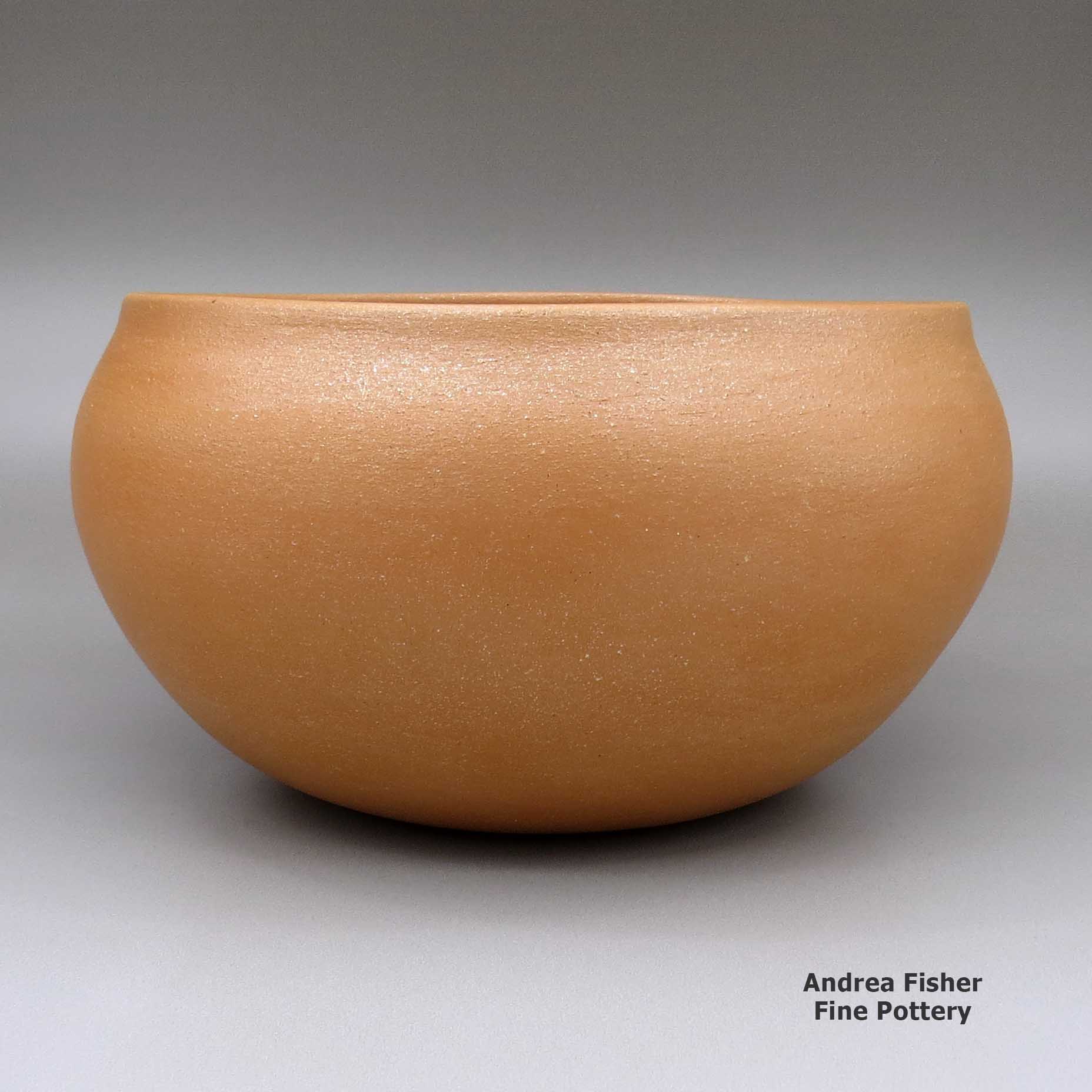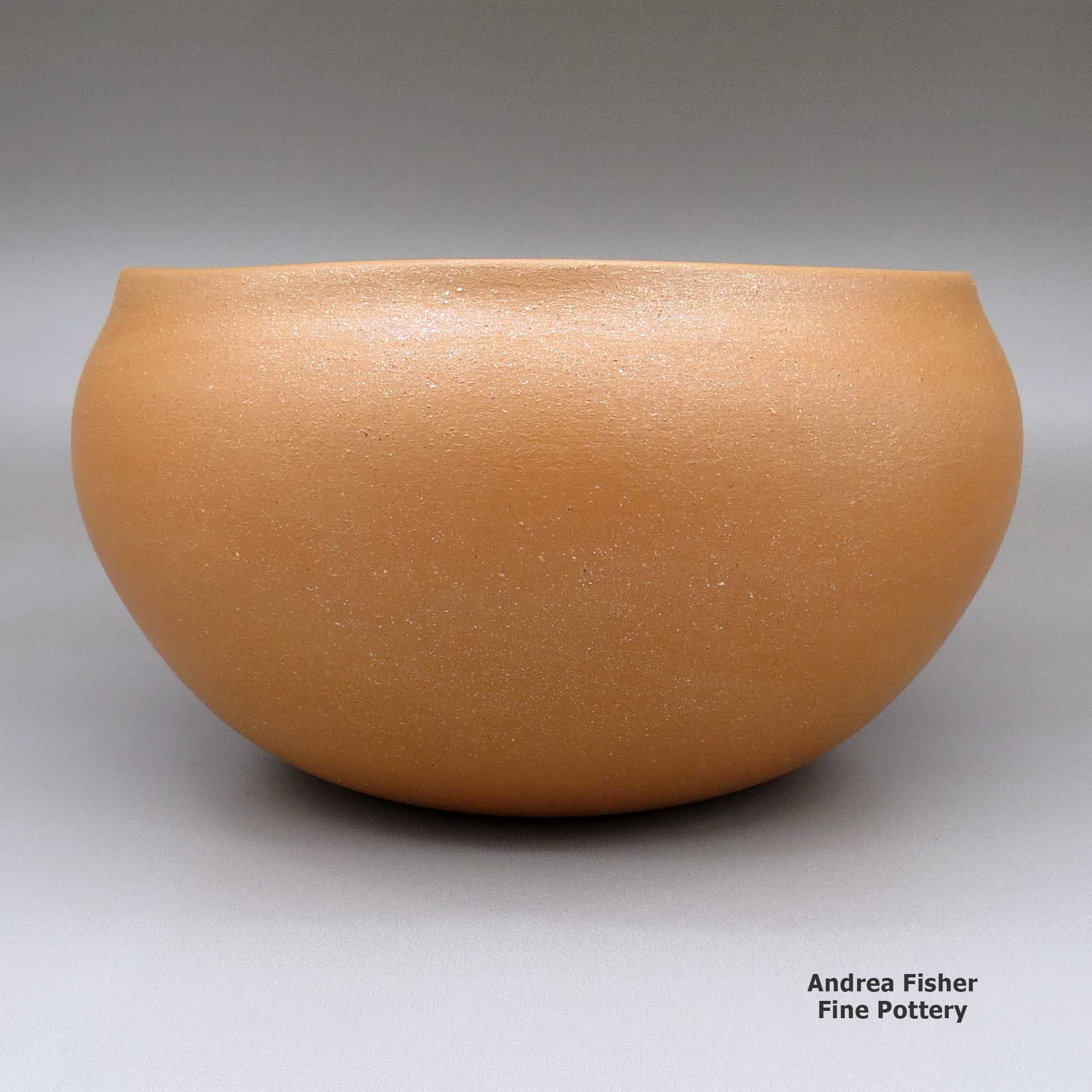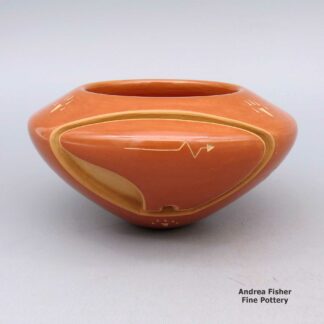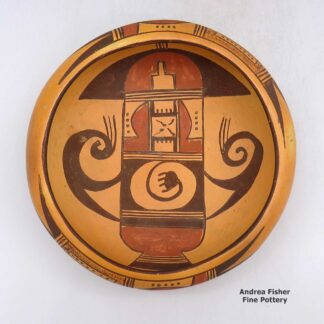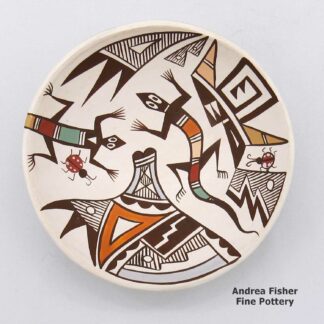| Dimensions | 11 × 11 × 6 in |
|---|---|
| Condition of Piece | Excellent |
| Date Born | 2022 |
| Signature | Khuu Khaayay Ohkay Owingeh |
Clarence Cruz, zzsj2m152m2, Micaceous gold bowl
$395.00
A utilitarian golden micaceous bowl
In stock
Brand
Cruz, Clarence
Ohkay Owingeh (formerly known as San Juan Pueblo) has a long history of pottery-making, going back to before the people left the four Corners area and headed southeast in the late 1200s CE. Archaeologists even date certain timespans in the Pueblo II era by the San Juan Polychrome and San Juan blackware pot sherds that have been found in many digs (although they trace the beginnings of that to the northern San Juan River watershed). The styles were so striking for the time that archaeologists have been able to reconstruct trade routes by the date of appearance of those styles in different pueblos. But the art of making pottery the traditional way is not so widespread at Ohkay Owingeh these days.
Clarence likes to gather all his materials himself, collecting his clays, slips, volcanic ash, mineral pigments and Rocky Mountain beeweed (for making black paint and for use as a binder) on public lands in northern New Mexico. He does all his firing the traditional way: outdoors using wood, bark and manure for reduction firing, oxidation firing and open firing (to create fire clouds).
A few years ago, Clarence retired from teaching graduate and undergraduate classes in Pueblo Pottery at the University of New Mexico. He has also shared his knowledge and experience in the Art and Design Department at Santa Fe Community College and in Native communities.
Because of his dedication and contributions to the art of traditional Pueblo pottery, in 2012 the Southwest Association of Indian Arts and the Santa Fe Indian Market awarded Clarence the Lifetime Achievement Allan Houser Legacy Award Honoring Pueblo Potters.
Clarence also took advantage of an opportunity to travel to China as part of a UNM faculty exhibition at the Jingdezhen Ceramic Institute.
UNM hired Clarence as Consultant Curator for the Inaugural Exhibition for the Alfonso Ortiz Center at the University's Maxwell Museum of Anthropology.
Clarence likes to make pottery using the shapes and designs of the Potsuwi'i tradition. He also likes to make golden micaceous utilitarian cooking pottery. Some people say that beans cooked in one of his bean pots are the best beans they've ever eaten.
Some of Clarence's works were part of the Place, Nations, Generations, Beings: 200 Years of Indigenous North American Art exhibit at the Yale University Art Gallery in New Haven, Connecticut, from November 1, 2019 to June 21, 2020. Note: the exhibit was based on objects from the Yale University collections and was accompanied by an exhibition catalogue.
A Short History of Ohkay Owingeh
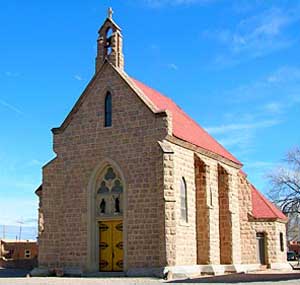
In 2005 San Juan Pueblo officially changed its name back to its original name (before the Spanish arrived): Ohkay Owingeh (meaning: Place of the strong people). The pueblo was founded after 1200 CE during the time of the great Southwest drought and migrations. The people speak Tewa and may have come to the Rio Grande area from southwestern Colorado or from the San Luis Valley in central Colorado.
Spanish conquistador Don Juan de Oñate took control of the pueblo in 1598, renaming it San Juan de los Caballeros (after his patron saint, John the Baptist). He established the first Spanish capitol of Nuevo Mexico across the Rio Grande in an area he named San Gabriel. In 1608, the capitol was moved south to an uninhabited area that became the Santa Fe we know today.
After 80 years of progressively deteriorating living conditions under Spanish rule, the people of Ohkay Owingeh participated in the Pueblo Revolt of 1680 (one of the revolt's ringleaders, Popé, was a spiritual leader at Ohkay Owingeh) and helped to expel the Spanish from Nuevo Mexico for 12 years. However, when the Spanish returned in 1692 that tribal unity had fallen apart and the individual pueblos were relatively easy for the Spanish to reconquer.
Today, Ohkay Owingeh is the largest Tewa-speaking pueblo (in population and land) but few of the younger generations are interested in carrying on with many of the tribe's traditional arts and crafts (such as the making of pottery). The pueblo is home to the Eight Northern Indian Pueblos Council, the Oke-Oweenge Arts Cooperative, the San Juan Lakes Recreation Area and the Ohkay Casino & Resort. The tribe's Tsay Corporation is one of northern New Mexico's largest private employers.
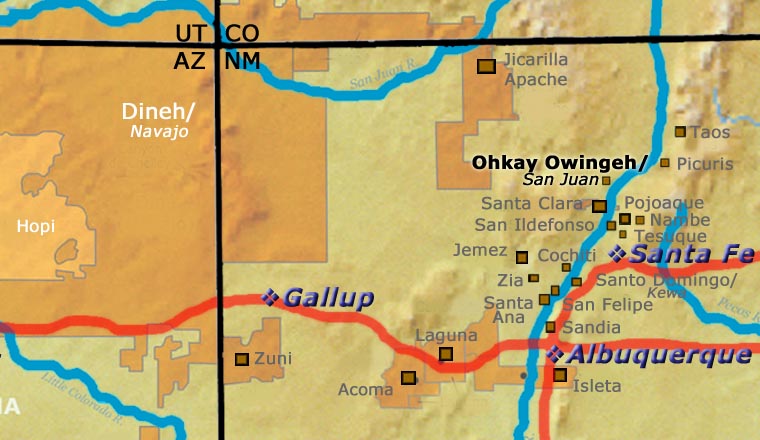
For more info:
Ohkay Owingeh at Wikipedia
Pueblos of the Rio Grande, Daniel Gibson, ISBN-13:978-1-887896-26-9, Rio Nuevo Publishers, 2001
About Utensils and Utilitarian Pottery
All pottery was purely utilitarian in the distant past. Dressing pottery up and decorating it is a relatively recent development. At the same time, the people of the pueblos have made (and still make) utensils and utilitarian pottery for more than 1500 years. Some modern potters have taken it upon themselves to recreate much of the ancient styles, shapes and designs, working with the same materials now as were used back then.
Hardly any of the modern Native American pottery will survive being used for cooking or serving food for long. The lone type of traditional pottery that would survive that is micaceous pottery, and not the surface-slipped kind but the full-body micaceous clay kind. There are still many people in northern New Mexico who say beans taste best when cooked in a micaceous clay pot. That requires a full body of micaceous clay.
In ancient days, though, they didn't have much choice with pots, pans and cooking or eating utensils. Utensils were made of wood, bone and fired clay. Cooking pots and serving bowls and platters were made of fired clay. Those that survived best were made of solid, high-density micacous clay. That kind of clay is possibly the hardest kind of clay for a traditional potter to work with: it is next to impossible to grind the clay into a fine powder because of the high concentration of mica.
About Micaceous Pottery
Micaceous clay pots are the only truly functional Pueblo pottery still being made. Some special micaceous pots can be used directly on the stove or in the oven for cooking. Some are also excellent for food storage. Some people say the best beans and chili they ever tasted were cooked in a micaceous bean pot. Whether you use them for cooking or storage or as additions to your collection of fine art, micaceous clay pots are a beautiful result of centuries of Pueblo pottery making.
Between Taos and Picuris Pueblos is US Hill. Somewhere on US Hill is a mica mine that has been in use for centuries. Excavations of ancient ruins and historic homesteads across the Southwest have found utensils and cooking pots that were made of this clay hundreds of years ago.
Not long ago, though, the making of micaceous pottery was a dying art. There were a couple potters at Taos and at Picuris still making utilitarian pieces but that was it. Then Lonnie Vigil felt the call, returned to Nambe Pueblo from Washington DC and learned to make the pottery he became famous for. His success brought others into the micaceous art marketplace.
Micaceous pots have a beautiful shimmer that comes from the high mica content in the clay. Mica is a composite mineral of aluminum and/or magnesium and various silicates. The Pueblos were using large sheets of translucent mica to make windows prior to the Spaniards arriving. It was the Spanish who brought a technique for making glass. There are eight mica mining areas in northern New Mexico with 54 mines spread among them. Most micaceous clay used in the making of modern Pueblo pottery comes from several different mines near Taos Pueblo.
Potters Robert Vigil and Clarence Cruz have told us there are two basic kinds of micaceous clay that most potters use. The first kind is extremely micaceous, often with mica in thick sheets. While the clay and the mica it contains can be broken down to make pottery, that same clay has to be used to form the entire final product. It can be coiled and scraped but that final product will always be thicker and heavier but perhaps smoother on the surface. This is the preferred micaceous clay for making utilitarian pottery and utensils. It is essentially waterproof and will conduct heat evenly.
The second kind is the preferred micaceous clay for most non-functional fine art pieces. It has less of a mica content with smaller embedded pieces of mica. It is more easily broken down by the potters and more easily made into a slip to cover a base made of other clay. Even as a slip, the mica serves to bond and strengthen everything it touches. The finished product can be thinner but often has a more bumpy surface than a polished piece. As a slip, it can also be used to paint over other colors of clay for added effect. However, these micaceous pots may be a bit more water resistant than other Pueblo pottery but they are not utilitarian and will not survive utilitarian use.
While all micaceous clay from the area around Taos and Picuris turns golden when fired in the open air, that same clay can be turned black by firing in an oxygen reduction atmosphere. Black fire clouds are also a common element on golden micaceous pottery but they are more a result of smoke touching the piece in random bursts of air.
Mica is a relatively common component of clay, it's just not as visible in most. Potters at Hopi, Zuni and Acoma have produced mica-flecked pottery in other colors using finely powdered mica flakes. Some potters at San Ildefonso, Santa Clara, Jemez and Ohkay Owingeh use micaceous slips to add sparkle to their pieces. Hubert Candelario of San Felipe said he gets his micaceous clay somewhere along the La Bajada escarpment near Santo Domingo. The color of the clay indicates that Mark Wayne Garcia of Santo Domingo gets his micaceous clay in the same place.
Potters from the Jicarilla Apache Nation collect their micaceous clay closer to home, in the Tusas Mountains. The makeup of that clay is different and it fires to a less golden/orange color than does Taos or La Bajada clay. Some clay from the Picuris area fires less golden/orange, too. Christine McHorse, a Dineh potter who married into Taos Pueblo, used various micaceous clays on her pieces depending on what the clay asked of her in the flow of her creating. Juanita Martinez, a figure-maker from Jemez Pueblo married into and moved to Taos Pueblo. There, she began decorating her figures with bands and lines of micaceous slips.
There is nothing in the makeup of a micaceous pot that would hinder a good sgraffito artist or light carver from doing her or his thing. Some potters are also adept at adding sculpted appliqués to their pieces and slipping them with micaceous clay. There are some who have learned to successfully paint directly on a micaceous surface. The sparkly surface in concert with the beauty of a simple, well-executed shape is a real testament to the artistry of a micaceous potter.
Archaeologists and historians have long pointed at Taos and Picuris Pueblos as the birthplaces of micaceous pottery but at the 1994 Micaceous Pottery Symposium at the School for Advanced Research in Santa Fe, Jicarilla Apache potter Felix Ortiz advanced the possibility that the people of Taos and Picuris learned how to make micaceous pottery from the Jicarilla Apache people. After all, it is Jicarilla Apache pottery made of micaceous clay from the southern Sangre de Cristo Mountains area that has been found as far away as Dismal River Culture settlements in Colorado and Nebraska and proto-Kiowa settlements in the Black Hills of South Dakota.

